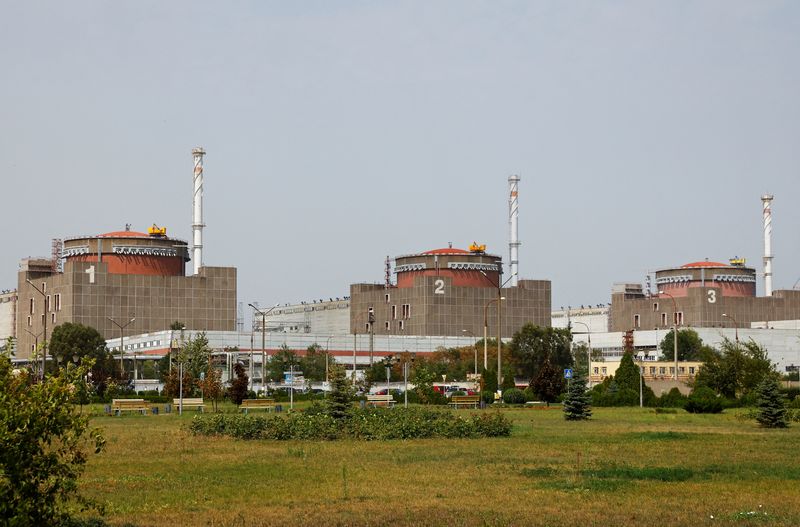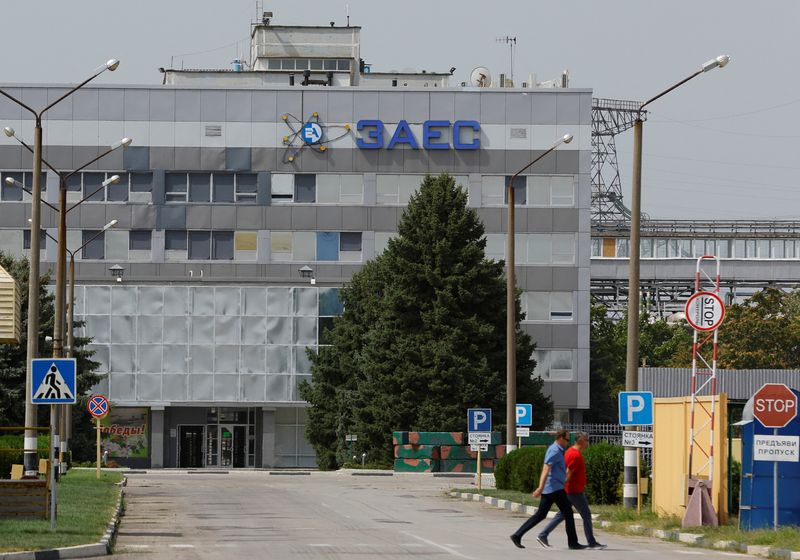By Francois Murphy
VIENNA (Reuters) – The last of four regular power lines supplying the Russian-held nuclear power plant at Zaporizhzhia in Ukraine was briefly cut on Thursday, meaning the plant had to resort to backup power for the first time, thinning its defences against a meltdown.
In all nuclear power plants, fission of nuclear fuel gives off heat to then produce steam that turns turbines to generate electricity. That process must be controlled to prevent a runaway chain reaction that would overheat and in the worst case cause a meltdown like those at Chornobyl or Fukushima.
Zaporizhzhia, in Russian-occupied southern Ukraine near front lines along the major Dnipro River, is Europe’s biggest nuclear power station and its area has been repeatedly hit by shelling in the past few weeks.
Reactors like the six at Zaporizhzhia, two of which are in operation, have a primary cooling circuit in which electrical pumps push water through the reactor core. Maintaining power supply is crucial to that working.
“If the cooling is interrupted, the fuel can heat up within a matter of hours to a temperature at which it can become damaged and begin to release highly radioactive fission products,” Edwin Lyman, director of nuclear power safety at the U.S.-based Union of Concerned Scientists, said in a blog post.
“If adequate cooling is not ultimately restored, the fuel can melt through the steel reactor vessel and — in the most severe situation — the containment structure can leak or rupture, releasing fission products to the environment.”
If the reactor has shut down, the fuel must still be cooled, as must spent fuel, but it can go without cooling for longer.
“They have to have power to the plant. They have to keep the nuclear fuel cool in the reactor,” said Mark Hibbs, senior fellow at the Nuclear Policy Program at the Carnegie Endowment for International Peace.
THREE LINES ‘LOST’
Given the importance of power supply, backups are built in.
There are four regular, 750-kilovolt (kV) power lines designed to supply Zaporizhzhia but three of them “were lost earlier during the conflict”, the International Atomic Energy Agency said in a statement on Ukraine on Thursday.
Ukraine informed the agency that the fourth line was cut at least twice on Thursday but was later restored. It was the first time all four regular lines had been down, Ukraine said. The cause was not immediately clear, the IAEA said.
In addition to the regular lines, Zaporizhzhia has a backup 330 kV line to a nearby coal-fired power plant.
Should all those lines fail, the plant is equipped with diesel generators that can tide it over briefly. Sources vary on how much fuel they have – somewhere between 72 hours’ and 10 days’ worth.
“That’s emergency power supply,” Hibbs said.
No independent outsiders have had access to Zaporizhzhia since Russian forces seized it in March.
“A secure off-site power supply from the grid is essential for ensuring nuclear safety,” the IAEA said.
Lyman was more candid: “The situation is growing much more dire as the external power supply becomes more fragile. You want to have multiple, reliable sources of off-site power and by all accounts they’re hanging on by a thread.”
(Reporting by Francois Murphy; Editing by Mark Heinrich)


